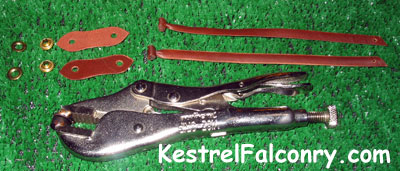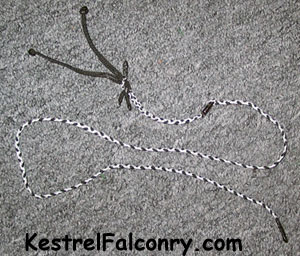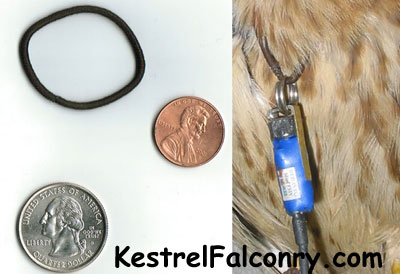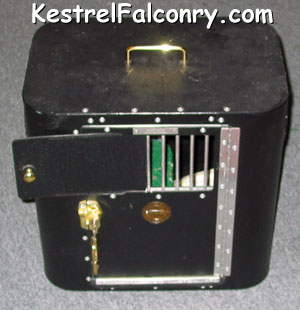Kestrel Falconry Equipment
Kestrels are small and the falconry equipment you use for a Kestrel shouldn't be too heavy or bulky. Check back in later when I have more time and I will tell you more than what is listed below..
Kestrel Falconry Equipment
Keeping equipment lightweight is going to let your Kestrel hunt and fly better. There are many "Apprentice Kestrel Equipment Kits" out on the market and price doesn't mean quality. Only buy what you need and get more equipment as you need it. There is no point in buying things you will never use or not use for years. For example, I don't think bells for a Kestrel are very appropriate, but it seems every kestrel kit comes with bells. Transmitters and Receivers cost more but are way more effective and realistic for a small bird like an American Kestrel.
**Something to think about before you buy**
If the weight of your transmitter + the gear to attach transmitter + anklets weighs more than 9-13 grams, then the bird is flying carrying around 10% more body weight. Try carrying around 10% of your own body weight and see how it feels. Now try to run and jump carrying 10% of your own body weight... Anyway, you get the idea....Keep the equipment light. For reference, the total weight of everything that my Kestrel has on while actually hunting/flying is 5.2 grams. 5.2 grams includes the anklets, grommets, Transmitter, neck-mount for Transmitter.
Main Types of Kestrel Equipment
Scales

The most important piece of equipment for Kestrel Falconry is a good scale. Kestrels are very light weight and have a high metabolism. Losing 20 grams is about 20% of their body weight and can be dangerous if done in a short period of time. The temperature outside can affect how quickly the Kestrel burns calories. Watch out on cold days and nights, Kestrels can lose weight very fast.
The type of scale pictured above is a Ohaus Triple beam scale. It measures in grams and is very accurate. Digital scales are usually off by 1-5 grams. I prefer a triple balance scale. If you do get a digital scale make sure to check the accuracy. Kestrels are very light and you want to really dial in the perfect weight.
Remember you will need some kind of small perch that attaches to your scale for the kestrel to sit on while you measure the weight. I made a small perch for the scale in the picture that I can wash easy if it gets dirty.
Jesses & Anklets
Keep them thin and light. When you first become a falconer don't feel pressure to make your own. Buying Jesses and Anklets saves time and you know you are getting a quality product. Anklets and Jesses are made from Kangaroo skin. Find a good supplier who will make ones specifically for Kestrels. Kestrel grommet size is 00. You will also need grommet pliers to set the grommets in the anklet leather. The bird will be flying while wearing the anklets so they need to be light. The total weight of the Anklets and Grommets that I use is 2.3 grams (not including jesses). I recently started making my own jesses and anklets. Kangaroo leather is expensive so measure twice cut once.
Falconry Perch/Block

Birds like to perch, that is what birds do, so it is important to understand what the bird is looking for in a perch and what you are looking for in a perch. Perches come in all sizes and shapes. The picture above shows common types. Starting on the left of the picture is: Ring Perch, Block Perch, Bow Perch, T-Perch. You want a perch that you can clean easily and/or easily change surface material where the birds feet make contact. Kestrel legs can be damaged easily if you don't take certain precautions. Traditionally, Falcons perch on a Falconry Block and Hawks perch on a Bow perch but Kestrels can use both without problems. I have a number of different perches, one for the car, one for general use, one for training on location. Remember, it is easy to damage Kestrel legs so don't have a long and heavy leash hanging from their legs.
I put down newspaper under the perches. Newspaper is cheap and can be changed quickly. Keep your Kestrel area clean.
Leash
The Leash connects the jesses to the perch or to your glove. There are many ways to do this by either using a braided leash and falconers knot or by using small clips. They both work well, just make sure that you don't have a heavy leash hanging on your kestrels legs. This will cause wear in one spot and lead to leg damage and/or bumble foot. Keep it light weight! There are many falconers that make awesome braided jesses. Making your own can be very time consuming and the final product probably won't be as good as if you bought it from a falconer that has been making these for many years. Plus you are supporting that falconer by purchasing their falconry gear.
Transmitters & Receivers
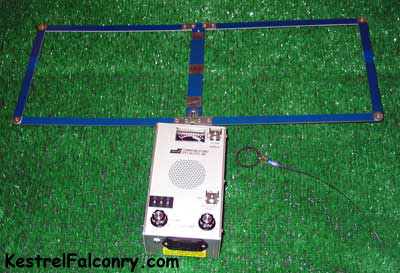
Transmitters: The Transmitter attaches to the bird and if your bird gets lost you use a Receiver to locate the bird. Rule 1 - More expensive doesn't mean better..... A lost kestrel is usually within 1/2 mile and usually a lot less. You want to buy a lightweight transmitter from one of the main transmitter companies. Here is my own unpaid opinion on buying a transmitter - I would rather buy two transmitters that cost $100 each than one transmitter that costs $200. Also, for the extra cost you are not gaining very much in terms of strength of signal, what you are getting by paying the extra money is a different way to turn off and on the transmitter. Right now my favorite transmitter company is Merlin systems. They make a great light weight transmitter. Merlin systems "FMV-mini" transmitter is not only light but it transmits very far and can transmit at a good strength for easily more than 48 hours(I will do some tests on its actual capabilities in the future). I am always looking for better equipment so if I see a better and/or more cost effective transmitter I will change my opinion on here.
There are different ways to mount a transmitter to your bird. The different methods are Backpack, Foot Mount, Neck Mount. I use the neck mount method. It is lighter than the backpack method and can be taken on and off the bird easily. Also, with the neck mount method if the bird gets caught in a branch or bush then they can pull out of the mount. The neck mount method is a little hair tie the size is shown in the picture and a small stainless split ring also shown. The picture above shows how a kestrel wears the neck mount. They preen the band into their feathers and can even cast through the neck mount. The total weight of my transmitter plus hair band plus stainless split ring is 2.9 grams. The transmitter attaches to the bird only when I go hunting or am free flying the bird to the lure.
Receivers: The Receiver is used to pin point which direction the bird is located. There are a few different companies that make receivers. My absolute favorite is the R-400 Receiver. It picks up many frequencies, works very well, and you can take it out and put it away quickly. I have tried a few other receivers like an Icom radio with a quick foldout yagi and nothing really compares to the R-400. If you want to buy 1 receiver that is going to last you a long time and that has multiple frequencies then a R-400 is the BEST. Again, I am always on the lookout for the best equipment so if/when I see a better receiver setup I will change my opinion on here.
The Kestrel Lure
The lure is very important in many ways. The lure is a way to retrieve your bird ASAP. The bird can see the lure from far away and it knows that it will get a big easy meal when it comes and catches it. The lure can be used for exercise and training. You can see some lure flying videos on our Lure Flying Videos Page here. Below is a video of how I make a falconry lure for a American Kestrel. I make the lure in the shape of a bat and I use a cord lock system to attach the meat to the lure.
Water Pan/Spray Bottle
Kestrels need additional water besides what is in the meat that they eat. Keep a water pan near their perch but ALSO offer water from a spray bottle or from droplets off your finger. An active bird has a very high metabolism and in a short period of time they can need water. Sour crop from too much food in one session can easily be cured by offering small amounts of water every 5-10 minutes. If the sour crop is really bad you can try water with 10% Pedialyte. At least once a day try to offer water from the spray bottle or from droplets off your finger.
Food & Vitamins
Kestrels have a very wide range in diet. In nature they eat bugs, rodents, and birds. Quality food will keep your Kestrel going strong. Wild meat is usually always better but you can use frozen quail with vitamin powder as a backup. Do not feed chicken or turkey to your Kestrel. DO NOT feed any kind of hot dogs or processed meats to your Kestrel......understand? Wild Starlings and House Sparrows are the best food overall you can offer. Even if you are feeding only starlings and house sparrows to your Kestrel, it is a good idea to add a little vitamin powder to the food. Do not put too much vitamin powder on the food or it will be way too salty and the bird won't like it. Daily and very light sprinkling is best. The best Raptor vitamin powder is Vita Hawk.
Falconry Hoods
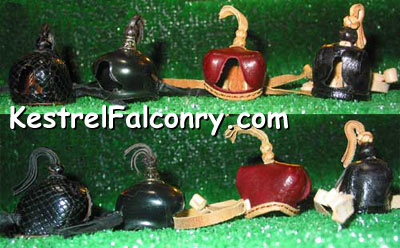
Kestrels can take a hood but do they need a hood? Hooding your Kestrel can be good at certain times in training or for calming down a bating bird. Chances are that if your Kestrel is Bating something else is wrong. It either needs food, water, better perch design, more frequent training sessions, etc. Some Kestrels I have hooded regularly and some I never hood. It is up to the falconer and where/how you want to transport the bird.
Giant Hood
Another option besides a normal falconry hood is a Giant Hood. A giant hood is a large box/carrying case to transport the bird. They are especially great for traveling in a car and for bringing a bird into places they aren't supposed to go...like a hotel room. The Giant Hood I use is made by Forest Hawk. Forest Hawk makes these GREAT giant hoods in many colors, shapes and sizes. It comes with a perch inside and has a lock for added security. They are very sturdy and I have stood on top of mine with zero problems. These are expensive but the attention to detail is amazing and well thought out. These are the best giant hoods money can buy! You can reach them at ForestHawkFalconry@Yahoo.com *Note* This is not a Mews. This is used only to transport your bird. Kestrels need alot more space for day to day life. This is NOT a "falcons home"....understand?
Falconry Pouch/Vest
Keep it simple and easy to clean, other than that it is up to your own style. Remember you need enough room for the items you will carry with you into the field. Items I carry in my falconry bag are: food "tidbits", Falconry and Hunting Licence, Car Keys, Cell phone, small knife and of course the Lure.
Medicines/Ointments/Etc
The only 3 items that I think are important in this category are Neosporin, Tea Tree Oil and Pedialyte. The Neosporin is really good for Kestrel legs. When I first trap a Kestrel I put Neosporin on their legs right before I put on the Anklets. Also if you start to see any signs of damage to your kestrels legs I clean the damage with tea tree oil and then put on the Neosporin. Tea tree oil dries out and cleans the wound very well but be very carefull to not get it in their mouth or eyes. Tea tree oil is very strong and can be applied with a Q-tip.
You should be checking their legs under the anklets every day especially the first couple weeks after trapping. For the first week after trapping I check the legs even more than once a day. Kestrels legs can be damaged QUICKLY, also you might have trapped a Kestrel that had some pre-existing leg condition already. Once leg/foot damage occurs it takes a long time to heal, so make sure to check their feet often for signs of damage.
The other item I suggested (Pedialyte) is not as important but if you do accidentally feed too much meat in one training session to your bird or if your bird shows signs of sour crop then water with 10% Pedialyte can work wonders.
Binoculars
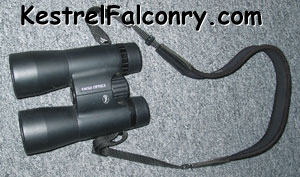
I don't carry binoculars into the field but I always have them in the car. They are great for finding potential slips and also for looking at other raptors in the area. Everyone has their own favorite brand of binoculars. My favorites are the Eagle Optics Ranger Platinum Class Binoculars. They are equal to binoculars that cost a lot more.They also have a great replacement guarantee if they get damaged.


